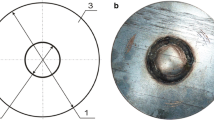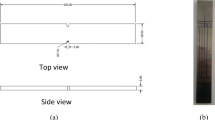Abstract
The magnetic memory of metal (MMM) is an after-effect, which occurs in the form of metal residual magnetization in components and welded joints formed in the course of their fabrication and cooling in the weak magnetic field of the earth and in the form of irreversible change of components’ magnetization in zones of stress concentration and damages under working loads (ISO 24497–1:2007(E)). The results of experimental investigation by the metal magnetic memory of steel specimens in the process of their static and cyclic loading are presented. Investigation using the MMM method was carried out online in the process of cyclic loading in the synchronous manner with load frequency. Specific features of self-magnetic field’s (SMLF) intensity variation at maximum load during tensile cyclic load were revealed. The obtained results of specimens investigation experimentally confirmed the earlier drawn conclusion about the possibility of the MMM method and corresponding inspection instruments application for quick testing of mechanical properties and cyclic strength parameters at the physical level. Comparison of σ–ε deformation curves and σ–ΔH x , ΔH x –ε magnetograms, obtained in the static loading mode, of σ–ε cyclic loading profiles and corresponding magnetograms confirms once more the earlier established correlation of magnetomechanical parameters conditioned by the “magnetodislocation hysteresis”. Fatigue curves, plotted by variation of the self-magnetic field of the specimens in the process of cyclic loading, experimentally confirm the possibility of equipment life assessment by parameters of the metal’s magnetic memory. Magnetograms, recorded online in the process of cyclic loading of specimens, allow claiming the possibility of the MMM method and the Tester of Stress Concentration type instruments application for technical state monitoring during operation of equipment under load conditions.





















Similar content being viewed by others
Notes
In Russia, for testing by MMM method special instruments—TSC (manufacturer Energodiagnostika Co. Ltd.) were certified by Federal Agency on Technical Regulating and Metrology (the National Standards Body) of the Russian Federation.
References
Vlasov VT, Dubov AA (2004) Physical bases of the metal magnetic memory method. ZAO “TISSO”, Moscow, p 424
IIW document V-1347-06 Training handbook. The method of metal magnetic memory (MMM) and inspection instruments
ISO 24497–1 (2007) (E) Non-destructive testing—metal magnetic memory—Part 1: Vocabulary
ISO 24497–2 (2007) (E) Non-destructive testing—metal magnetic memory—Part 2: General requirements
ISO 24497–3 (2007) (E) Non-destructive testing—metal magnetic memory—Part 3: Inspection of welded joints
Dubov AA (1997) Investigation of metal properties using the effect of the magnetic memory of metal//Physical metallurgy and heat treatment of metals, 9
Goritsky VM, Dubov AA, Demin EA (2000) Investigation of structural damageability of steel samples using the metal magnetic memory method. Control Diagnostics 7:35–39
Makhutov N.A., Dubov A.A., Kolokolnikov S.M., Denisov A.S. (2008) Investigation of steel specimens for static and cyclic load using the metal magnetic memory method. Proceeding of 21st International Congress and Exhibition COMADEM-2008 (Condition Monitoring and Diagnostic Engineering Management), Czech Republic, Prague, June 11–13. p. 319–330
Standard of JSC “GAZPROM” 2–5.1-148-2007. Testing methods of steel and welded joints stress corrosion cracking
Author information
Authors and Affiliations
Corresponding author
Additional information
Doc. IIW-2168, recommended for publication by Commission V “NDT and Quality Assurance of Welded Products”.
Rights and permissions
About this article
Cite this article
Dubov, A., Kolokolnikov, S. The metal magnetic memory method application for online monitoring of damage development in steel pipes and welded joints specimens. Weld World 57, 123–136 (2013). https://doi.org/10.1007/s40194-012-0011-5
Received:
Accepted:
Published:
Issue Date:
DOI: https://doi.org/10.1007/s40194-012-0011-5




